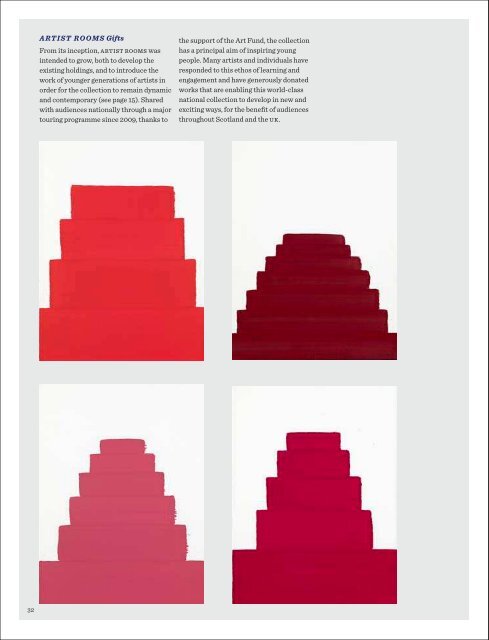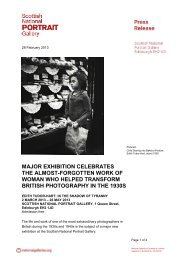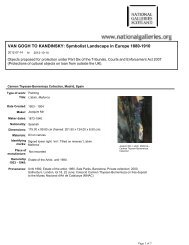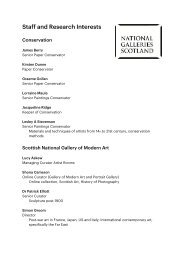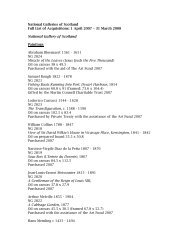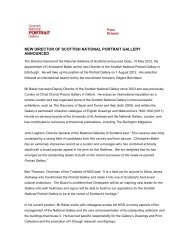Annual Review 2011-12 - National Galleries of Scotland
Annual Review 2011-12 - National Galleries of Scotland
Annual Review 2011-12 - National Galleries of Scotland
You also want an ePaper? Increase the reach of your titles
YUMPU automatically turns print PDFs into web optimized ePapers that Google loves.
ARTIST ROOMS Gifts<br />
From its inception, ARTIST ROOMS was<br />
intended to grow, both to develop the<br />
existing holdings, and to introduce the<br />
work <strong>of</strong> younger generations <strong>of</strong> artists in<br />
order for the collection to remain dynamic<br />
and contemporary (see page 15). Shared<br />
with audiences nationally through a major<br />
touring programme since 2009, thanks to<br />
the support <strong>of</strong> the Art Fund, the collection<br />
has a principal aim <strong>of</strong> inspiring young<br />
people. Many artists and individuals have<br />
responded to this ethos <strong>of</strong> learning and<br />
engagement and have generously donated<br />
works that are enabling this world-class<br />
national collection to develop in new and<br />
exciting ways, for the benefit <strong>of</strong> audiences<br />
throughout <strong>Scotland</strong> and the UK.<br />
M A RT I N C R E E D ( b. 1 968)<br />
Work No. 1102, <strong>2011</strong><br />
Acrylic on canvas, 61 x 45.7cm<br />
Work No. 1103, <strong>2011</strong><br />
Oil on canvas, 61 x 45.7cm<br />
Work No. 1104, <strong>2011</strong><br />
Acrylic on canvas, 61 x 45.7cm<br />
Work No. 1105, <strong>2011</strong><br />
Acrylic on canvas, 61 x 45.7cm<br />
ARTIST ROOMS Presented by the artist<br />
jointly to <strong>National</strong> <strong>Galleries</strong> <strong>of</strong> <strong>Scotland</strong><br />
and Tate and acquired with assistance<br />
<strong>of</strong> the ARTIST ROOMS Endowment,<br />
supported by the Henry Moore<br />
Foundation and Tate Members <strong>2011</strong>.<br />
© Martin Creed<br />
Martin Creed’s work emerges from an<br />
ongoing series <strong>of</strong> investigations into<br />
commonplace objects and actions.<br />
Creed titles his works primarily using<br />
numbers, so that each piece is added<br />
to his catalogue with equal status,<br />
regardless <strong>of</strong> its size, or medium.<br />
Through subtle interventions or<br />
apparently simple processes, he<br />
reintroduces the viewer to elements<br />
<strong>of</strong> the everyday and the ordinary that<br />
are otherwise overlooked. Creed has<br />
made numerous works that deal with<br />
notions <strong>of</strong> subtraction and addition,<br />
stacking and progression. The artist has<br />
generously presented a group <strong>of</strong> seven<br />
works to NGS and Tate for ARTIST ROOMS,<br />
<strong>of</strong> which these four recent paintings<br />
represent an important aspect <strong>of</strong> the<br />
artist’s practice. In such works, Creed<br />
builds up broad lines <strong>of</strong> paint across the<br />
canvas in decreasing lengths that together<br />
create a stepped pyramid. Each painting<br />
differs in terms <strong>of</strong> the width and number<br />
<strong>of</strong> lines, following a set <strong>of</strong> rules that resist<br />
processes <strong>of</strong> decision-making. Although<br />
individually titled, together the four<br />
paintings form a series that can be exhibited<br />
together.<br />
R O B E RT M A P P L ETHORPE<br />
( 1 9 4 6 –1989)<br />
David Hockney, 1976<br />
Silver gelatine print, 50.8 x 40.6cm<br />
Feet, 1982<br />
Silver gelatine print, 50.8 x 40.6cm<br />
ARTIST ROOMS <strong>National</strong> <strong>Galleries</strong> <strong>of</strong><br />
<strong>Scotland</strong> and Tate. Presented by the<br />
Robert Mapplethorpe Foundation 2010.<br />
© Robert Mapplethorpe Foundation.<br />
Used by permission.<br />
The acclaimed American artist Robert<br />
Mapplethorpe used photography as a<br />
means <strong>of</strong> exploring the physical and<br />
sculptural potential <strong>of</strong> objects and the<br />
human form. Originally trained as a<br />
painter and sculptor at Pratt Institute,<br />
Brooklyn, New York, he did not see<br />
himself as a ‘photographer’. Rather, his<br />
practice with the medium initially developed<br />
out <strong>of</strong> an interest in using photographic<br />
images found in magazines and<br />
books. He went on to take his own photographs<br />
in order to control his compositions<br />
more directly. His distinctive style<br />
possesses a classical quality that revels<br />
in the sensualism <strong>of</strong> nature and the body.<br />
By the time <strong>of</strong> his premature death from<br />
AIDS in 1989 he had created a powerful<br />
body <strong>of</strong> work that spanned portraiture<br />
<strong>of</strong> artists, writers and actors, floral still<br />
lifes, male and female nudes, figurative<br />
studies, and erotic images which engaged<br />
with sexual politics through frank and<br />
frequently provocative compositions.<br />
The explicit nature <strong>of</strong> many <strong>of</strong> his works<br />
caused controversy, testing the very<br />
right to individual freedom <strong>of</strong> expression.<br />
Mapplethorpe triumphed over<br />
legal campaigns, and his work therefore<br />
holds a significant place in the history <strong>of</strong><br />
artistic struggle.<br />
32 33


